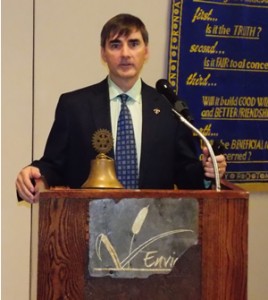August 7, 2012
By: Amy Connor-Flores
 Hugh Caffery, Chairman of the Board of Commissioners for the Bayou Lafourche Fresh Water District, updated us on the state of Bayou Lafourche on Tuesday.
Hugh Caffery, Chairman of the Board of Commissioners for the Bayou Lafourche Fresh Water District, updated us on the state of Bayou Lafourche on Tuesday.
In recent decades the bed of Bayou Lafourche has been steadily building up, significantly reducing flow from the Mississippi River.
In 2011 the BLFWD held its first Bayou Lafourche Summit, bringing together 200 customers, partners, citizens, and elected officials to determine what needs to be done to achieve the District’s goal of getting freshwater to the people of the area and to the keep the Bayou clean and beautiful. They developed a Master Plan to provide guidance to the District as it attempts to manage Bayou Lafourche.
$200,000,000 CIAP Funding – The first dredge project is currently underway and has helped to identify additional areas near the current dredge project and above Thibodaux that will require work.
The dreading of these additional areas will cost more than $20,000,000. The District has been encouraged to work with the Coastal Protection and Restoration Authority, as well as the Office of Coastal Protection and Restoration, to apply for Coastal Impact Assistance funding for these projects.
Operation and Maintenance Plan – An O & M Manual for the project has been provided to the District, which outlines the frequency for maintenance dredging of the sediment trap within the project area. Funding for this project, which has an estimated annual cost of $300,000 has not yet been determined. The District will develop detailed funding plans for these projects.
Communicate this Master Plan to all bayou Lafourche users. The 2011 Summit highlighted the Projects identified as needed.
Identify and Secure Funding for all of the Master Plan Projects.
Renew Millage – Currently, the District collects a 2.11 mill tax, which is set to expire in 2014. It has been renewed in 10 year periods for many years and should renew in the next 12 months. It has been suggested that it be renewed for a longer term with a possible issuing of bonds. A millage renewal election will occur to determine the outcome.
Update Water Usage Fees – The user fee program will also need to be updated to align the funding stream with the demand for water. A multi-year plan should be developed by the District to increase its fees gradually so as to be sensitive to the ability of the end user to afford these increases.
Support Terrebonne Parish – There is an initiative for Terrebonne to join the District as a member. It is currently a contractual customer and is also the largest user of the fresh water resources that the District provides. The millage would be applied to Terrebonne if a vote by Terrebonne Parish Council results in the Parish becoming a member of the District. The election has not been scheduled at this time, but it is expected to be called in the next 12 months.
Future Communication Plan – The District will develop a strategy to open communication to these groups including ideas such as email updates and board meetings.
Control Vegetation – The most persistent problem facing the District is control of the vegetation in the Bayou. The aggressive growth of hydrilla clogs the waterway and limits the ability of the District to provide clean water to its customers.
Floating mechanical harvesters are currently being used to manage the problem, but this method is often un able to keep up with the growth. Other options are currently being investigated, including the use of insects that eat the vegetation, as well as using a brush clearing chain along the bottom of the bayou. The District will most likely need to budget $200,000 over the next two years to pursue these options.
Develop a Program to Prevent Saltwater Intrusion into potable/freshwater intakes. A major threat to the Lafourche and Terrebonne Water Plants is salt water intrusion from the Gulf.
Define the Drainage Area feeing the Bayou – BLFWD should determine which areas drain into and away from the bayou.
Prevent Flooding in Donaldsonville – Large rains in this area create problems because of two things: 1-The District operates a large pump station in Donaldsonville and this section of the bayou is very narrow. The increase or decrease in pumping has a direct effect on the bayou’s water level. 2-The section of the bayou is also the primary drainage artery for the drainage waters from the City.
Coastal Restoration – There is a great interest in using the bayou to restore the coast since it is an existing conduit between the River and areas with the greatest need.
Clean Up and Enhance the Beauty of the bayou water and the bayou banks, remove threatening trees, sewerage, debris, structures, abandoned vessels, etc.
Increase Flow Through Railroad Crossing – Current culverts are not large enough to allow for the maximum amount of flow that the pump station can produce.
Increase Pump/Flow Capacity to 1000 CFS – It is currently has approximately 300 cu. ft/sec. when all 4 pumps are operation at peak efficiency and capacity.
Remove Thibodaux Weir and consider installing a weir just below the Terrebonne water intake canal and deployable weirs to preserve adequate freshwater supply in all cases.
Provide additional Access to the Bayou: Identify the needs, secure and develop the needed boat launches, viewing, recreation areas, etc.
Define BLFWD Authority both current and needed, in consultation with our legislators.
Individuals can help by speaking with the commissioners, getting informed, and sharing the vision with others about the bayou project. The most powerful tool in accomplishing the BLFWD’s goal is word of mouth. Business owners, residents, and users up and down Bayou Lafourche must be made aware if the plan and share its goals and objectives if the project is to be successful.
